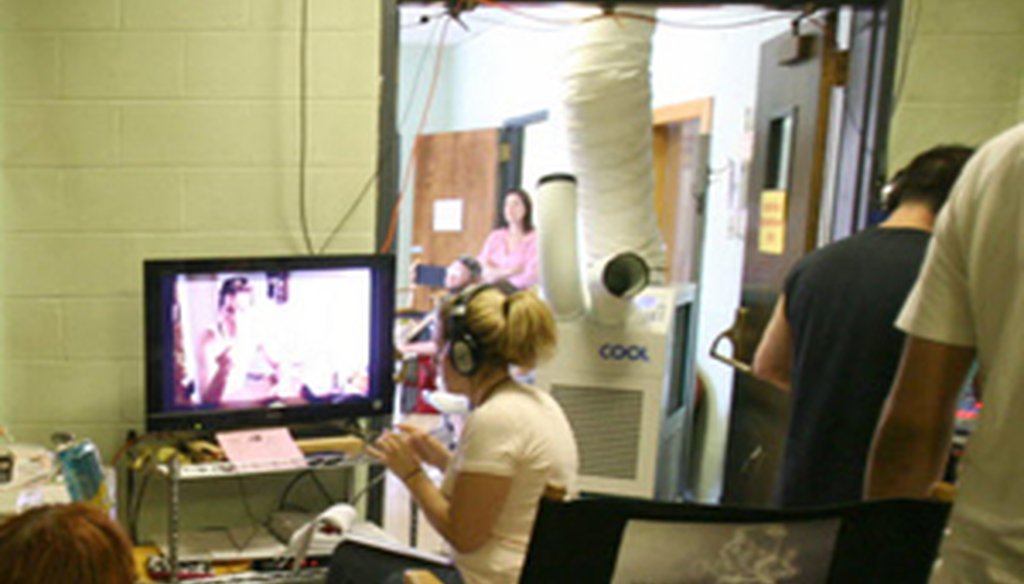Stand up for the facts!
Our only agenda is to publish the truth so you can be an informed participant in democracy.
We need your help.
I would like to contribute

A Michael Corrente movie being shot at the old Cranston police station in July, 2010. The Providence Journal/Kathy Borchers
Want to turn a $1 investment into an $8 return in a matter of a few months? Just offer the money in the form of a tax break for movie and television production companies.
Talk about movie magic!
That's what happens, said Senate President Teresa Paiva Weed when she spoke Dec. 3 during a State House reception for the production company behind "Body of Proof," the TV drama filmed in Rhode Island and scheduled to be aired on ABC. The state's tax credit helped make that happen by subsidizing movie and television productions.
"I was one of the skeptics when the film tax credit came out. I was one of the folks that said, 'How does this work?' 'I'm not sure.' 'Will this really work?' And I have come, through much education from my colleagues over the years, to become a real believer because we now know that it works, for all the reasons I've already said. A recent study showed that the film tax credit generates $8 for every $1 of investment in our state. And I can't think of a better investment that also builds on our tourism industry."
We were curious about whether the $1 becomes $8 rate of return was really that high.
Paiva Weed said the source of her comment comes from an April 2010 report by Edward M. Mazze, professor of business at the University of Rhode Island, who concluded that from 2005 to 2009, Rhode Island gave up $56.7 million in revenue in the form of tax credits to 46 productions projects. In return, the projects generated $466 million, direct and indirectly, in wages and taxes. Dividing $466 million by $56.7 million gives you the 8-to-1 ratio.
The credit system allows a production company to get a tax credit equal to 25 percent of its Rhode Island production costs if it spends at least $300,000 on items "directly attributable to activity within the state."
Mazze's estimate comes from looking at how much the production companies claimed they spent on products and services in Rhode Island, along with wages and salaries paid in Rhode Island. To gauge the indirect benefits -- such as extra wages paid out to hotel, restaurant and catering employees hired to support the production -- he turned to the U.S. Department of Commerce, which estimates how much the direct benefit spills over into other sectors. For motion picture and TV production, the feds say that's about 84 percent of the direct benefit. Then Mazze took those estimated wages and salaries and estimated that 10.2 percent of that went toward state and local taxes, based on annual figures from The Tax Foundation, a business-backed tax policy group.
If you restrict yourself to tax revenue directly raised through the credit program, Mazze's study suggests that the state gets 60 cents in taxes for every dollar spent on the credits. (Over the past five years, the amount has fluctuated from 50 cents in 2006 to 94 cents in 2009.)
But other studies that have tried to assess the value of the credits have reached very different conclusions, and some of the numbers vary widely.
Connecticut said the credits were worth 8 cents on the dollar. A Massachusetts study pegged the number at 16 cents.
In New Mexico, one of the states with the longest history of using subsidies to attract the film industry, researchers at New Mexico State University concluded that the rate of return was just 14 cents per dollar invested. Yet five months after that August 2008 study was released, the New Mexico State Film Office issued a report by the accounting firm Ernst & Young saying that the state's film tax credit had generated $1.50 in revenue for every dollar spent.
The results are dramatically different because "when you're comparing studies, the methodologies are different, and that makes it very very tough" to compare, said Mazze.
So this is like the blind men and the elephant -- each study "sees" something different depending on what they choose to look at.
Those who look for short-term tax income usually find that the tax credit system actually costs a state money, which, earlier this month, prompted the left-leaning Center on Budget and Policy Priorities in Washington, D.C., to liken the belief that the subsidies are a cost-effective tool for creating jobs and income to "a Hollywood fantasy."
Mazze believes the tax credit system is more than simply calculating how many tax dollars are immediately returned to the state's coffers. "I think, down the road, you're paying less taxes."
"Any type of government spending is going to generate jobs," said Anthony V. Popp, one of the authors of the New Mexico State University study. "But from an economic development point of view, you want to develop jobs that will stay there and generate revenues over a long period of time. Because of the footlooselessness of the [film] industry, they're not developing things and staying. They're going to the state that gives them the best deal."
"The real question is, where do you spend the money so it's the best bang for the buck," Popp said. "And the fact is, if you left that with the taxpayer, what would be the net effect?"
Taking Popp's question a step further, would a tax cut of $56.7 million do more for the Rhode Island economy? As far as we know, that study hasn't been done.
So, in the end, Paiva Weed is speaking the truth when she says that a study has concluded that the state gets back $8 for every $1 invested in tax breaks for motion picture and television production. But the Masse report is one of several studies that cast the costs and benefits of film credits all over the map.
For that reason, we decided not to issue a ruling on her statement. Perhaps at some point we'll be comfortable saying whether film tax credits are a pot of gold, or just another Hollywood special effect.
Our Sources
Facebook Video, "Welcoming Body of Proof to Rhode Island (Part 1)," Rhode Island Senate, accessed Dec. 13, 2010
Interview, Teresa Paiva Weed, president, Rhode Island Senate, Dec. 14, 2010
Report, "The Economic Impact of the Motion Picture Production Tax Credit on the Rhode Island Economy for the Years 2005-2009" by Edward M. Mazze, www.film.ri.gov, April 2010, accessed Dec. 13, 2010
Interviews, Edward M. Mazze, professor of business, University of Rhode Island, Dec. 15-16, 2010
Report, "Motion Picture Tax Incentives: There's No Business Like Show Business," State Tax Notes, March 13, 2006, accessed Dec. 14, 2010
ProJo.com, "Reviews for state's film tax credit aren't good," Aug. 12, 2008.
Mass.gov, "A Report on the Massachusetts Film Industry Tax Incentives," Department of Revenue, July 2009, accessed Dec. 15, 2010
CBPP.org, "State Film Subsidies: Not Much Bang for Too Many Bucks," Center of Budget and Policy Priorities, Dec. 9, 2010, accessed Dec. 15, 2010
Interview, Anthony V. Popp, professor emeritus, department of economics and international business, New Mexico State University, Dec. 17, 2010




























